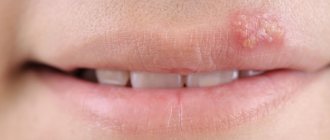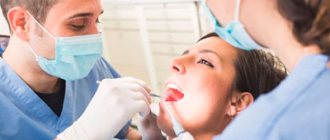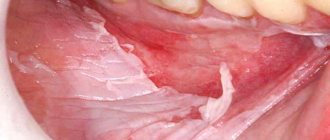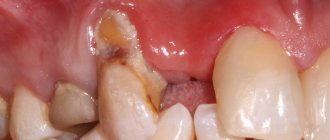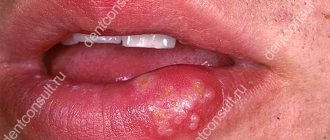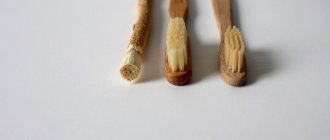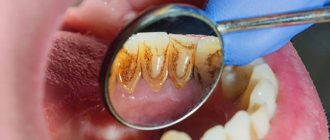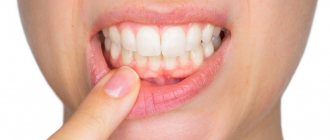Suspect No. 1 – herpes
- Cause. When pimples appear on the lips, the cause may be the activation of the herpes virus, which occurs under the influence of external factors, for example, hypothermia.
- Emergence. Before the rash appears, swelling and pain occur, then severe itching appears, after which vesicular pimples on the lip “ripen.”
- Localization. Most often, herpes is localized along the edges of the lips or in their corners.
- Appearance. With herpes on the lip, pimples resemble vague blisters with liquid. They do not have a specific shape, they are more like spots.
- Quantity. Multiple rashes.
- Feel. Patients with herpes experience burning and itching.
If pimples on the lip turn out to be a manifestation of herpes, doctors prescribe antiviral drugs. This disease should not be left to chance, because after the bubbles burst, the virus spreads along with the leaked liquid, and a new rash appears.
What should you not do if you have a pimple on your lip?
When a pimple appears on your lip, the first thing that comes to mind is to squeeze it out, treat it with alcohol to dry it, or with a wound-healing ointment that you have lying around in your medicine cabinet. This is strictly forbidden. If the rash on your lips is herpes, squeezing it can only lead to more spread of the virus. Not every ointment (cream, gel or solution) is suitable for combating rashes. Here's what else you can't do if a purulent pimple appears on your lip:
- Use lipstick or balm. It is recommended to change lip product every 2 months, as bacteria and other pathogenic microorganisms accumulate on it.
- Use alcohol solutions if the rash is on the inside of the lip. Alcohol can burn the mucous membranes.
- Use peelings. Wherever the rash appears, it should not be treated with abrasive particles. So, for acne, peelings are used only during remission of the disease.
Suspect No. 2 – acne
- Cause. Acne is a multifactorial disease. The main links in its pathogenesis are hyperkeratosis, excessive sebum production, colonization of propionibacteria, and inflammation. For example, if a small whitehead appears on the lip, a blockage of the sebaceous gland could occur, leading to the formation of a closed comedon.
- Emergence. Acne usually appears suddenly.
- Localization. With acne, pimples rarely appear on the lip, since there are few sebaceous glands in this area. Most of them are in the so-called seborrheic zone - the nose, forehead, chin, this is where acne occurs most often.
- Spring view. A slight swelling of red color; if a purulent pimple has formed on the lip, then a white head can be seen inside, the acne takes a cone-shaped shape.
- Quantity. Most often they pop out one at a time. In severe cases of acne, they may merge.
- Feel. Papules and pustules may be painful, especially when palpated.
After opening, the acne fades, so many people think that this is a great way to get rid of them, but this approach can lead to aggravation of the problem, an even greater spread of the rash.
Pimples on the lips: causes
Acne on the lip may appear for the following reasons:
- herpes virus;
- blockage of the sebaceous glands;
- stress, psycho-emotional disorders;
- allergic reaction;
- disruptions in the functioning of the facial nerves;
- improper hygiene;
- endocrine disorders;
- eating large amounts of sweets and fatty foods.
Only a doctor can determine the exact cause of the appearance of a pimple on your lip, so before you run to the pharmacy for the ointment that you prescribed for yourself, it is better to first visit a specialist and entrust him with drawing up a treatment plan.
How to deal with acne?
Treatment for acne depends on the severity of the disease. It is prescribed exclusively by a specialist. For mild to moderate acne, external therapy is primarily used18. For severe acne, emphasis is placed on systemic treatment18.
Clindovit® is a topical antibiotic that can be prescribed for acne vulgaris6. The main active ingredient in its composition is the antibiotic lincosamide clindamycin6. It fights a wide range of propionibacteria strains6. After contact with the skin, clindamycin quickly accumulates in comedones, exhibiting antimicrobial activity6. Clindovit® gel helps reduce free fatty acids on the skin6.
The drug must be applied twice a day (morning and evening) to previously cleansed and dry skin. The first results from treatment with a topical antibiotic usually become noticeable after 6-8 weeks. It is recommended to combine the use of the drug with the use of benzoyl peroxide or azelaic acid (Azelik® gel)18,28.
Causes and treatment of acne on the upper lip
There are many nerve endings concentrated in the lip area, so if any inflammation has formed on the skin in this area, then acne can be very painful. Pimples appear above the upper, lower lip and in the corners of the lips. They are not always pathological; more often they are simply a cosmetic defect.
It was never possible to establish a clear cause for the appearance of defects, and for each case the appropriate doctor selects individual treatment. If acne appears, you can contact a dermatologist, cosmetologist, gynecologist, endocrinologist and other doctors.
Causes
When acne appears once and in small quantities, most often the cause may be internal pathologies of the body. Despite the fact that a specific disease in which the skin above the lip and around the mouth “sprinkles” has not been identified, there are many factors that provoke the rash. Among them are:
- Hormonal drugs and glucocorticosteroids. Most often, ointments and creams containing hormones are used to treat certain skin diseases. The use of drugs with prednisolone or hydrocortisone without prescription or after an incorrect diagnosis can aggravate the disease. Treatment with medications based on other hormones can worsen the rash. They may be found in skin care products.
- External environmental conditions. Acne can appear when a person acclimatizes, when exposed to frost, sun, and wind.
- Poor quality or incorrectly selected cosmetics. Inflammation on the skin occurs after the pores become clogged as a result of daily skin care. Acne can appear after any cosmetic product: lotion, skin cleansing milk and others that a person uses daily.
- Microorganisms. On the surface of human skin and in hair follicles there are pathogenic microorganisms, which, when the body’s immune defense is reduced and multiply, provoke inflammation of the follicle and the appearance of purulent contents.
- Toothpaste. Fluoride-containing toothpaste worsens the condition of the skin and provokes inflammation.
- Hormonal imbalance. In women, pimples above the lip most often occur on certain days of the menstrual cycle. Taking oral hormonal contraceptives causes hormonal imbalance.
- General decrease in immunity, stress and hypothermia. When the body's general defenses weaken, pathogenic agents begin to grow, so acne may appear during this period.
- Various diseases. Pathologies of the nervous and endocrine systems, diseases of the gastrointestinal tract (gastrointestinal tract).
- If skin problems are caused by a hereditary predisposition, then they appear after birth and are chronic throughout life.
- Allergy. Allergic rashes occur after various irritants enter the body.
Rashes above the lip most often occur in women; in men they are less common. In representatives of the stronger sex, acne appears in 2 cases:
- in case of disruption of the intestines, liver, stomach and pancreas;
- with a lack or excess of hormones.
What kind of acne
Small rashes that do not have purulent content inside and are characterized by redness, itching and peeling are classified as simple dermatitis. Purulent acne is characteristic of an infectious lesion, which is accompanied by an increase in body temperature.
It is believed that pimples with a white purulent head provoke various pathologies of the pilosebaceous follicles. The rash can also be caused by perioral dermatitis or any other skin disease.
Diseases
With seborrheic dermatitis, acne occurs when the sebaceous glands become clogged with sebum and become inflamed. These rashes are accompanied by severe itching and upon detailed examination, yellow or white scales are found in the area of the hair shaft.
Demodex is a disease that appears when the subcutaneous mite becomes active. Impetigo occurs due to a staphylococcal or streptococcal infection. Herpes is most often localized directly on the lips and is characterized by severe pain.
Treatment with medications
In case of hormonal imbalance, you should contact an endocrinologist for treatment. The doctor will order a blood test for hormones and prescribe appropriate therapy. It is worth stopping taking hormonal medications for a while.
If the cause of the rash is hidden in unsuitable environmental conditions, then you should use products with UV protection; in winter, a cream with a greasy structure. The means should be selected according to the weather. Cosmetic products must be chosen carefully. Most often, pimples above the lip appear due to cosmetics that contain petroleum jelly, paraffin, and cinnamon flavoring. These components clog the skin.
To eliminate microorganisms on the surface of the skin, it is necessary to increase immunity and use drugs that contain imidazole, a substance that affects the vital activity of pathogens. If you have allergic acne, you should stop eating foods and using products with irritants. If inflammation is caused by toothpaste with fluoride, you should stop brushing your teeth with it.
You can get rid of acne of a viral nature of herpes if you cure it in a short time with the use of medications. You can buy Acyclovir or its more expensive analogue Zovirax at the pharmacy. Medications will speed up healing and get rid of the virus in a few days.
Acyclovir eliminates acne on the upper lip
The ointment is applied pointwise to the area of the rash every 4 hours.
Common dermatitis on the face should be treated with anti-inflammatory and emollient creams and powders. Seborrheic dermatitis requires treatment with antifungal drugs with miconazole and nizoral.
Demodex is treated with local medications to eliminate mites and systemic remedies for this pathology. Antiparasitic medications include Metronidazole and Ornidazole, and desensitizing medications include Suprastin, Tavegil and Diazolin. Impetigo is treated on an outpatient basis.
Diazolin eliminates acne on the upper lip
In cases where self-treatment does not bring results or the acne covers a large area, it is necessary to seek help from a doctor in order to identify the pathology and begin treatment as early as possible.
General treatment recommendations
If acne appears, you should consult a doctor and undergo examination. If the appearance of inflammation above the upper lip is caused by diseases, then there is no general treatment algorithm, and everything is decided individually together with a specialist.
General treatment recommendations:
- Squeezing pimples above the lip is strictly prohibited; damage leads to the formation of a boil or the spread of infection.
- Treating the inflamed tissue will help speed healing and prevent infection. Rubbing with alcohol will dry out the inflammation and stop the development and spread of infection.
- Before applying a cosmetic product (cream, lipstick), you should spread a small amount of the product on the back of your hand.
- To improve the condition of your skin, you need to eat well, give up coffee, hot, fatty, salty and spicy foods.
- It is necessary to avoid stress and hypothermia.
- You can take a vitamin complex; nicotinic and folic acid, riboflavin, ascorutin, and vitamin B6 are especially useful.
You can treat inflammation with folk remedies, but you need to wait longer for results. The following methods are used as auxiliary treatment:
- You can lubricate the inflammation with garlic juice; this recipe is good for treating infectious rashes.
- Rubbing with fir and tea tree essential oil helps. These substances dry out inflammation, accelerate maturation, and stimulate regeneration.
If you find an error, please select a piece of text and press Ctrl+Enter.
The most effective remedies for acne on the face -
How to remove acne from the face quickly and without complications? The most difficult thing here is to choose the right combination of drugs and draw up a treatment regimen taking into account the specific clinical situation. Below you can see that the approach to treating acne on the face may differ - depending on the predominance of different types of inflammatory elements (papules or pustules), as well as on the severity of the disease. The most effective remedies for acne on the face:
- antibiotics,
- products with benzoyl peroxide,
- topical retinoids,
- oral contraceptives in women,
- phototherapy (IPL), photodynamic therapy and lasers,
- comedones extraction method.
Only a dermatologist or a dermatologist-cosmetologist can professionally treat acne on the face. Unfortunately, in most cases, patients seek consultation with a specialist late, and this leads to complications - the appearance of persistent age spots, as well as superficial atrophic scars. Below you can see a treatment plan for acne, which is based on recommendations from the most famous English-language textbook for dermatologists around the world, Fitzpatrick's Dermatology.
How to get rid of acne on your face (according to Fitzpatrick's Dermatology):
Below we will look at all the types of drugs that are indicated in this scheme, and now you will know for sure which ointment for acne on the face will be the best in your case. Please note that azelaic and salicylic acids are not the main remedy for acne on the face, and can only be used as “second-tier” drugs. You can find out more about them at the link above. At the same link you can learn about the use of oral contraceptives in women.
Appearance of perioral acne
Typically, the affected area of skin has a light pink or red tint.
Inflammations can be called small nodules that contain fluid. They can be grouped or located separately from each other. Together, groups of pimples become inflamed and resemble acne. How to distinguish acne that appears due to dermatitis around the mouth? They are rough, a little itchy, and there is a constant feeling of tightness on the skin. However, there are no skin rashes directly around the lips, approximately 3-5 mm. These signs distinguish pimples with perioral dermatitis from rosacea and rosacea. If the disease is started and treatment is not started in time, it will affect new areas of the skin. To prevent this, you need to immediately contact a dermatologist, otherwise his help alone will not be enough.
Pimples on the forehead or chin in women: causes
Why do acne form on the chin in women? The reasons here may also be hidden in hormonal background. The fact is that increased concentrations of androgens can occur not only in adolescents. Clinical studies show that 30% of women with acne have laboratory confirmed absolute hyperandrogenism, i.e. increased production of androgens of ovarian or adrenal origin.
Acne in middle-aged women is most often localized in the chin and cheeks; sometimes women also experience acne on the forehead:
We have already said above that in women, in the period from 2 to 7 days after ovulation, current symptoms of acne may arise or intensify. This is due to peak concentrations of luteinizing hormone, which promotes the transformation of androstenedione into testosterone, and the latter, thanks to enzymes, is already converted into dihydrotestosterone. Therefore, taking into account all the above-mentioned causes of acne in women, a remedy for acne on the face, such as oral contraceptives or antiandrogens, can be used as part of complex therapy.
Another cause of acne in women may be the use of oral contraceptives based on pure progesterone. This is due to the fact that sebocytes (these are the cells of the sebaceous glands that produce fatty secretions) have receptors not only for androgens, but also for progesterone. However, the largest group of adult acne patients (both women and men) do not have an increase in androgen production, but they still have overactive sebaceous glands. What this is connected with - read below.
Other causes of acne in adults -
As we said above, the sebaceous glands have receptors for androgens. The fact is that hyperactivity of the sebaceous glands can occur even with normal concentrations of androgens (if these receptors, due to genetics, have increased sensitivity to androgens). The receptors become more sensitive to androgens due to increased activity of the following enzymes: 17-β GSD, 3-β GSD, and 5 α-reductase. The first 2 enzymes convert dehydroepiandrosterone and androstenedione into free testosterone, and 5 α-reductase further converts testosterone into dihydrotestosterone (24stoma.ru).
In general, it is precisely due to the increased activity of these enzymes that in men and women there is an increase in the concentration of dihydrotestosterone (even if the level of androgens is normal). It is dihydrotestosterone that is the main and direct hormonal stimulator of the activity of the sebaceous glands. Studies have shown that in patients with acne and pimples, the synthesis of dihydrotestosterone in the sebaceous glands is increased from 2 to 30 times - compared to patients without acne symptoms. And, by the way, one of the markers of increased activity of these enzymes is the presence of androgenic alopecia in the patient (which occurs not only in men).
Phototherapy and lasers for acne treatment
Phototherapy and lasers are used to treat acne - either endogenous porphyrins contained in P. acnes, or sources of exogenous porphyrins are additionally applied to the skin before the procedure. Porphyrins have the property of absorbing light in the blue regions of the spectrum (wavelength 415 nm), which leads to the formation of unstable oxygen and, as a result, to the destruction of pathogenic bacteria P.acnes. The FDA recommends Lumenis devices (for example, the IPL module of the M-22 device), which use high-intensity light from the blue part of the spectrum, for the treatment of papulopustular acne, i.e. acne.
Light from the red part of the spectrum can also be useful because... Compared to blue light, it has a stronger anti-inflammatory effect (although it has a lesser effect on porphyrins). Therefore, a combination of light from the blue and red parts of the spectrum will be even more useful. Facial procedures are carried out 2 times a week for 15 minutes. According to the dermatology textbook Fitzpatrick's Dermatology, after a 4-week course of therapy in 80% of patients, the number of acne decreased by 60%. But in the absence of supporting procedures, their number returns to the original level - within 3-6 months.
Photodynamic therapy is even more effective in treating acne. It consists of applying exogenous porphyrins to the skin 1 hour before the procedure (aminolevulinic acid/ALA), after which exposure to a high-power light source occurs. The latter can be pulsed dye lasers, intense pulsed light or a broadband light source in the red part of the spectrum. ALA is metabolized in the sebaceous glands and hair follicle to porphyrins, which when exposed to light lead to the release of unstable oxygen, which damages the sebaceous glands. Several photodynamic therapy treatments can provide improvement for up to 5 months.
Pulsed KTP laser (wavelength 532 nm) - also leads to a reduction in the number of acne by about 40%. Use this laser 2 times a week for 2 weeks (a total of 4 treatments are required). In addition, some of the non-ablative infrared lasers at 1450 nm and 1320 nm wavelengths may also be useful for treating acne. they cause thermal damage to the sebaceous glands. However, any of these lasers requires a course of several treatments (and the improvement lasts up to about 6 months).
One of the newest acne treatment devices is the Isolaz device (from Solta Medical). The nozzle of the device is made in the form of a photo-pneumatic device, which creates negative pressure that sucks out the fatty secretion from the mouths of the hair follicles. Immediately after this, broadband pulsed light (wavelength from 400 to 1200 nm) is turned on, which acts on the P. acnes porphyrins, destroying these bacteria, and also has an anti-inflammatory effect.
What do phototherapy and lasers do?
Regular use in courses not only improves the course of acne, thereby reducing the number of inflammatory elements. The use of phototherapy (IPL) and lasers in courses often avoids the need for oral medications (antibiotics, isotretinoin), as well as the numerous side effects associated with them. But the cost of such treatment is high. We hope that our article on the topic: How to remove acne on your face was useful to you!
Sources:
1. Higher medical education of the author of the article, 2. Textbook on dermatology “Fitzpatrick's Dermatology” (8th edition), 3. “Modern methods of treatment and rehabilitation of patients with acne vulgaris” (Barinova), 4. “Acne from the position of evidence-based medicine” (Anisimova), 5. “Cellular mechanisms of barrier protective functions of the skin and their disorders in skin diseases” (Medelets).
